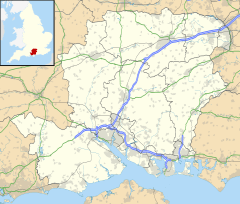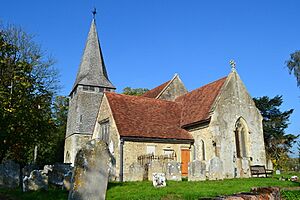Nursling facts for kids
Quick facts for kids Nursling |
|
|---|---|
| Village | |
 Junction of Mill Lane and Station Road, Nursling |
|
| Population | 5,137 (2011 Census) |
| OS grid reference | SU371163 |
| Civil parish |
|
| District |
|
| Shire county | |
| Region | |
| Country | England |
| Sovereign state | United Kingdom |
| Post town | Southampton |
| Postcode district | SO16 |
| Dialling code | 023 |
| Police | Hampshire |
| Fire | Hampshire |
| Ambulance | South Central |
| EU Parliament | South East England |
| UK Parliament |
|
Nursling is a village in Hampshire, England. It is part of the Nursling and Rownhams area. The village is about 6 kilometers (4 miles) north-west of the city of Southampton.
Nursling was once known by different names. These included Nhutscelle, Nutsall, Nutshalling, or Nutshullyng. Over time, it has grown closer to Southampton. However, it is still part of the Test Valley area, not Southampton itself.
Contents
A Look Back: Nursling's History
Long ago, the Romans built a bridge in Nursling. This bridge crossed the River Test. There are also signs of an old Roman road that went from Nursling to Stoney Cross.
The Old Monastery
In 686, a Benedictine monastery was built here. This was one of the first Benedictine places in Wessex. It became a very important place for learning.
A famous person named Winfrith studied here. He later became Saint Boniface. He wrote the first Latin grammar book in England. Saint Boniface left in 710. He returned briefly before going to Germany as a missionary.
The Danes destroyed the monastery in 878. It was never rebuilt. We don't know exactly where it was. However, the local church is named after Saint Boniface.
Nursling in the Domesday Book
The Domesday Survey was a big survey of England. It said that 30 households lived in Nursling. At that time, the village belonged to the Bishop of Winchester.
The Church of St. Boniface
The Church of St. Boniface was mostly built in the 1300s. Some parts might be even older, from the 1200s or even Saxon times. The church was repaired in 1881 and again in 1890.
Famous People and Places
In 1778, a rectory (a house for a church leader) was built across from the church. This building is now called Nursling House.
During World War II, an archeologist named O. G. S. Crawford lived in Nursling. He kept important historical maps safe in his garage. This saved them from being destroyed in an air raid on Southampton.
A famous cricketer, William Henry Harrison, was born in Nursling.
In 1931, Nursling had 727 people. In 1932, it joined with Rownhams to form "Nursling and Rownhams."
Nursling Today
Nursling has a busy industrial area. It is next to the M271 motorway. Many big businesses are located here, like Tesco. The motorway makes it easy to reach the Southampton container port. It also connects to other major roads.
Nursling is also home to an ambulance station. This station helps serve the Southampton area.
Grove Place
Grove Place is a very old and important building in Nursling. It is a Grade I listed building. This means it is protected for its special history and architecture.
Grove Place was once a large country house. Later, it became a hospital for people with mental health issues. After that, it was a private school for boys, then a girls' school. Today, it has been changed into apartments for retired people.



